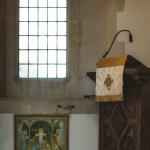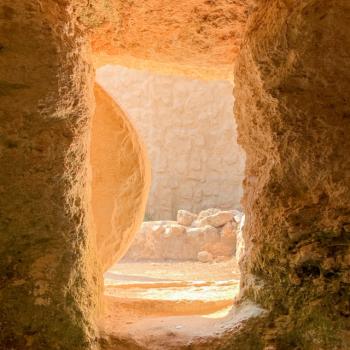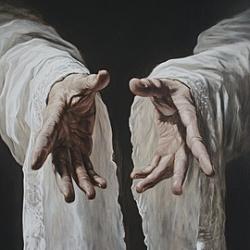Jesus took with him Peter and John and James, and went up on the mountain to pray. And while he was praying, the appearance of his face changed, and his clothes became dazzling white. Suddenly they saw two men, Moses and Elijah, talking to him. They appeared in glory and were speaking of his departure, which he was about to accomplish at Jerusalem. Now Peter and his companions were weighed down with sleep; but since they had stayed awake, they saw his glory and the two men who stood with him. Just as they were leaving him, Peter said to Jesus, “Master, it is good for us to be here; let us make three dwellings, one for you, one for Moses, and one for Elijah” —not knowing what he said. While he was saying this, a cloud came and overshadowed them; and they were terrified as they entered the cloud. Then from the cloud came a voice that said, “This is my Son, my Chosen; listen to him!” When the voice had spoken, Jesus was found alone. And they kept silent and in those days told no one any of the things they had seen. (Luke 9:28-36)
Earlier this year Tim Keller died from pancreatic cancer. Keller was the founding pastor Redeemer Presbyterian in Manhattan and had built a vibrant parish in the heart of New York where he spoke to people’s lives and hearts.
As one of his friends noted, “Cancer, for Dr. Keller, was an old nemesis. Back in 2002, he was first diagnosed with thyroid cancer, a battle he would fight between 2003 and 2004. God would heal and restore Keller, but not before thyroid surgery knocked him out of the pulpit for three months.”
A decade later Keller wrote about that experience and talked candidly about a vision that he experienced as he was being rolled into the operating room:
There have not been many times in my life when I felt “the peace that passes understanding.” But there was one time for which I am very grateful. . . . It was just before my cancer surgery. My thyroid was about to be removed, and after that, I faced a treatment with radioactive iodine to destroy any residual cancerous thyroid tissue in my body. Of course my whole family and I were shaken by it all, and deeply anxious. On the morning of my surgery, after I said my good-byes to my wife and sons, I was wheeled into a room to be prepped. And in the moments before they gave me the anesthetic, I prayed. To my surprise, I got a sudden, clear new perspective on everything. It seemed to me that the universe was an enormous realm of joy, mirth, and high beauty. Of course it was — didn’t the triune God make it to be filled with his own boundless joy, wisdom, love, and delight? And within this great globe of glory was only one little speck of darkness — our world — where there was temporarily pain and suffering. But it was only one speck, and soon that speck would fade away and everything would be light. And I thought, “It doesn’t really matter how the surgery goes. Everything will be all right. Me — my wife, my children, my church — will all be all right.” I went to sleep with a bright peace on my heart.
Keller’s story may sound like it could not possibly have anything to do with Luke’s description of the Transfiguration. Jesus, Moses and Elijah do not appear to him. There is no mountain involved. He is confined to the antiseptic surroundings of a hospital. Keller is not surrounded by others, as Jesus was accompanied by his disciples. He is alone. But there is more similarity between the two encounters than one might suppose.
Both Keller’s experience and the Transfiguration are the stuff of visions. Both are experienced in that half-awake, half-asleep space where we may think that we are inattentive. But in such moments but we are sometimes we are more focused than we think. Our field of vision is narrowed. We subject to fewer distractions. And we see things for the way that they are and more deeply than we usually do.
Both bore a message from God. It doesn’t matter whether there was an audible voice involved. What Keller and the disciples heard, they heard clearly; and they had no doubt that it was God speaking to them. And both visions carried with them the unmistakable message that God’s Son has conquered the power of death.
They also differ, of course. Keller’s describes his vision in didactic fashion, and he summarizes the conclusion that he reached and the peace that followed. The elements of the Transfiguration carry that message, and one needs to know something about Old Testament history and symbolism to understand what the disciples were seeing.
Moses and Elijah are important in this regard: Moses represents the Law. Elijah represents the prophets. And together they represent the whole of the Old Testament and – therefore – the history of God’s efforts to deliver humanity from its bondage to sin and death. Their presence with Jesus underlines that fact that in Jesus, the centuries-long effort God has made to reach his children is coming to a conclusion. And Jesus has embraced that effort, bringing it to fulfillment.
We miss how central that effort is to the ministry of Jesus and the message of the Gospel. Death is the last enemy. Its presence in the world is a challenge to God’s claim to be the author of life. And, therefore, the Resurrection is not just a word of hope but an act of vindication, underlining the legitimacy of Jesus’s claim to be the Son of God.
Moses also represents those who have died, and Elijah represents those who are alive, because the Old Testament describes him as having been taken up to heaven. As such they represent the whole of humanity and what older translations of the creeds described as “the quick and the dead”. By virtue of his Resurrection, Jesus is the judge of humankind. God’s Kingdom, God’s will, should be the decisive concern of our lives. And the entire encounter takes place on the mountain, just as God’s Law was given to the children of Israel at Sinai.
But, for all the differences between Keller’s vision and the Transfiguration, there is still one, all important similarity: They are both visions that center our lives.
Keller’s vision gave him peace as he faced surgery years ago for one kind of cancer. And -according to everything I have read – it centered him in his last battle with cancer which came to an end earlier this year. The Transfiguration was meant to do the same thing for the disciples as Jesus finished the work that he was doing.
We tend to think of visions as strange and alien. Something given to people who are just a bit wifty or suggestable. And we are inclined to believe that if they have any value, they take us out of ourselves and far, far from trouble. That conviction prompted an older generation of atheists and skeptics to suggest that the message of Scripture was “the opium of the people”, as Marx put it. And, even today, skeptics write off the Transfiguration and the Resurrection as part of an escapist vision.
But those experiences drove the church out of Palestine into the larger Greco-Roman world, across the Roman Empire. The disciples who saw the transfigured and risen Christ, witnessed to the truth and the power of those experiences at the expense of their own lives. And it is – as inheritors of those experiences – that today’s Christians are the inheritors of that vision.
In a season of wealth and plenty, in a season of violence and international threats, in a season of civic discord and debate, where are you centered? If you are old or young, if you are starting out or wondering when to retire, where are you centered? If you are filled with joy or burdened with grief, where are you centered? If you are strong and healthy or weak and ill, where are you centered? If death seems like a distant rumor or it is a constant companion, where are you centered?
There are many ways to answer those questions. And many of them are fragile comfort – focused on our strength, which can fail; dependent on our knowledge, which can fade; centered on the good things of life and love, which are – themselves – transient and mortal.
But there is one vision, one promise, one deed – completed in Jesus Christ, who is Lord over all, including death. And the vision with which the disciples were entrusted points to that triumph, which centers all our lives.
Photo by Ruan Richard Rodrigues on Unsplash














